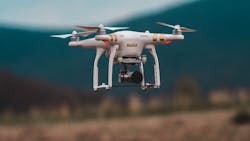Spending on Robots and Drones Forecast to Hit $128.7 Billion in 2020
In 2020, the sky will be buzzing with drones and the robots will be on the march.
That's because sales of these technologies will increase substantially, 17.19% in 2020, from 2019. According to a new study from the International Data Corp. (IDC)., worldwide spending on robotics systems and drones will be $128.7 billion in 2020.
And by 2023, IDC expects this spending will reach $241.4 billion with a compound annual growth rate (CAGR) of 19.8%.
Breaking down the sales by category, robotics systems will be the larger of the two categories throughout the five-year forecast period with worldwide robotics spending forecast to be $112.4 billion in 2020.
Spending on drones will total $16.3 billion in 2020 but is forecast to grow at a faster rate (33.3% CAGR) than robotics systems (17.8% CAGR).
Hardware purchases will dominate the robotics market with 60% of all spending going toward robotic systems, after-market robotics hardware, and system hardware.
Purchases of industrial robots and service robots will total more than $30 billion in 2020.
Meanwhile, robotics-related software spending will mostly go toward purchases of command and control applications and robotics-specific applications.
Services spending will be spread across several segments, including systems integration, application management, and hardware deployment and support. Services spending is forecast to grow at a slightly faster rate (21.3% CAGR) than software or hardware spending (21.2% CAGR and 15.5% CAGR, respectively).
"Software developments are among the most important trends currently shaping the robotic industry," said Remy Glaisner Jr., research director, Worldwide Robotics" at IDC. "Solution providers are progressively integrating additional software-based, often cloud-based, functionalities into robotics systems. An operational-centric example is an asset management application to monitor the robotic equipment performance in real-time. It aligns solutions with current expectations for modern operational technology at large and plays in facilitated adoption by operations leaders.
"Equally important is the early trend driven by burgeoning 'software-defined' capabilities for robotics and drone solutions, Glaisner added. " The purpose is to enable systems beyond some of the limitations imposed by hardware and to open up entirely new sets of commercially viable use-cases."
Discrete manufacturing will be responsible for nearly half of all robotics systems spending worldwide in 2020 with purchases totaling $53.8 billion. The next largest industries for robotics systems will be process manufacturing, resource industries, healthcare, and retail. The industries that will see the fastest growth in robotics spending over the 2019-2023 forecast are wholesale (30.5% CAGR), retail (29.3% CAGR), and construction (25.2% CAGR).
